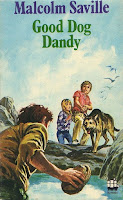About six weeks ago I re-read ‘The Secret of Galleybird Pit’, one of the lesser-known children’s books by Malcolm Saville (best known for his ‘Lone Pine’ series). So I decided to re-read the sequel, ‘Good Dog Dandy’, another book which I probably hadn’t read for close to fifty years. There’s a note in the front saying that I bought it in January 1974 so I’m sure I read it soon afterwards, and possibly a couple of years later, but as far as I know I haven’t read it since.
In any case, I had totally forgotten the plot and had no idea who the dog Dandy might be. I hadn’t been all that impressed with ‘The Secret of Galleybird Pit’, but liked the characters of Lucy (12) and Humf (9) so was looking forward to meeting them again.
This book starts as the school summer holidays begin. Lucy and Humf have been invited to go camping with some of their friends, and there’s a fair bit of discussion about that. Humf is very excited about a police demonstration he saw at his school, which included a police dog - Dandy of the title - and his ambition is to join the police force and train dogs like Dandy.
Their parents run a cafe, which is starting to get a good reputation in the village, and is just beginning to make a profit, but money is still tight. And Mervyn, the father, is not very good with money. Having a flawed adult in the family is an unusual feature of a book for children of this era, and while it’s handled well - Mervyn seems quite realistic - I’m not sure what age-group would find this book most interesting. Theoretically it’s for ages 9-12, but some of the adult interactions would be way over the head of most nine-year-olds.
The main plot involves some crooks who have been raiding local farmhouses; they are typically left unlocked during the daytime, making it easy for unscrupulous people to pop in. This storyline runs through the book, involving a woman calling herself an artist and a young, scruffy man who isn’t following exactly what the artist tells him to do. But we don’t get to meet them directly until towards the end.
There’s a fair bit of description of geographical locations that the author clearly knew well and loved, which brings the book alive even if it’s a tad long-winded in places. Lucy and Humf are well-developed characters (even if Humf appears to be almost a clone of Dickie Morton in the Lone Pine books) and their parents, too: their mother works too hard, their father is very fond of them all but really quite immature and self-centred, if genial. Lucy tries to keep the peace, aware of her father’s failings and sometimes angry with him.
It took a while for the book to get going, but once I was into the story, I thought it was well done. There’s some tension, some light moments when Humf becomes particularly enthusiastic, some poignancy, and a nice, if predictable climax when everyone comes together to celebrate Lucy and Humf’s mother’s birthday.
Apparently there’s a third book in this series, but I don’t have it and it’s not currently in print. I didn’t like the first two sufficiently to want to look for the third one second-hand although I suppose if I ever see it in a charity shop I might pick it up, for the sake of completion.
I thought ‘Good Dog Dandy’ was more coherent and also more enjoyable than ‘The Secret of Galleybird Pit’, and worth reading by those who like Malcolm Saville’s writing. Perhaps a fluent reader of about ten or eleven might like this, particularly if they are interested in camping and police dogs, or it could make a good read-aloud. Despite being a sequel, it could easily stand alone. But I’m not surprised it’s out of print, and unlikely to be in many libraries; so only really found in children’s sections at second-hand bookshops.

No comments:
Post a Comment